FiiO K7
FiiO K7 Long term Review
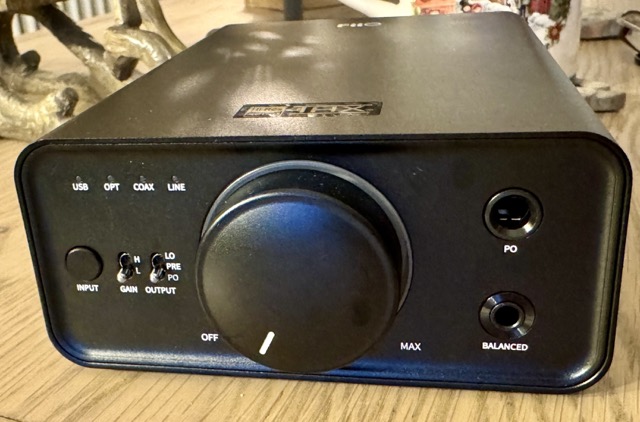
Introduction
So early this year I decided to upgrade my headphones from the usual Sennheiser and AKG ones and I decided I needed some Planar magnetic headphones and while my previous headphone amp, a Fosi Audio one was fine with the dynamic drivers I had previously it only sounded ok with these harder to drive Planar’s. It didn’t seem to have sufficent power especially with the low frequencies bass, to get these new headphones sounding as good as I expected. So after doing some research I decided a FiiO K7 and it was a revelation the difference a quality headphone Amp with sufficient power can make is incredible. So I thought after about 6 months of usage I would share some of my experience with the K7.
Since it is a while since the K7 was released and there are lots of other reviews already online, I decided to focus on a few key points that I believe are still relevant after 6 months of usage, so read on to see what I think of the K7.
Packaging and Unboxing:
My experience with FiiO products is they are exceptionally well packaged and FiiO when appropriate will provide a good range of accessories and with the K7 this is again evident.
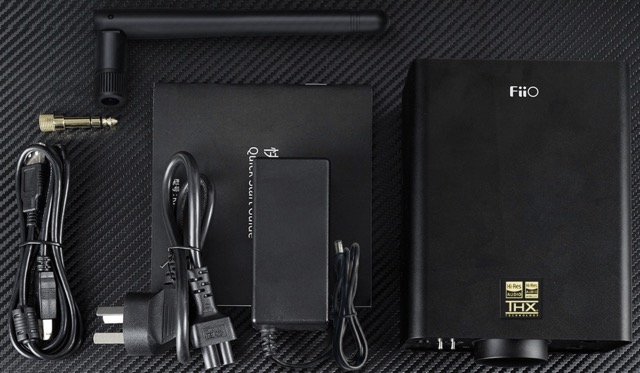
The box contained a quality power supply, a quality USB cable, a 6.35mm 1/4Inch Male to 3.5mm 1/8 Inch Female headphone adapter and of course the star of the show the “K7” itself.
Build Quality: FiiO K7
Note: I had no interested in bluetooth so got the non-BT version but I will reference the BT where I think it might be relevant.
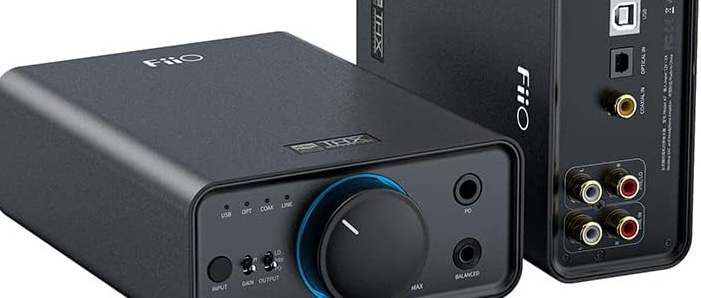
Front
The front panel of the K7 is similar to FiiO other offering, the K5Pro and the K9. It sports a sleek, low-profile input button replacing the traditional lever. This modification, coupled with two strategically placed switches for gain control and output selection, elevates the unit’s ergonomic appeal. Above these controls, four white LEDs, a visual cue for the active input is a nice touch.
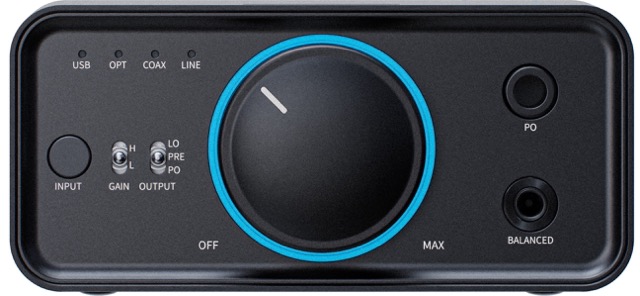
Notably, the K7’s volume wheel, a central feature is alson probably the most “controversal” aspect of the design. There are 2 key aspects of the design of the volume wheel are probably crucial to your feelings about the K7.
- It has ambient glow around the volume, with a different color depending on the source playing
- It’s a digital Volume control that is subtle at low volumes but much larger at higher volumes so can be non-intuitive compared to other devices.
So with the first point above, FiiO now have a firmware update that can be applied to remove this ambient glow. I personally like it so hadn’t applied that update, but it is one of those things that can annoy people so I thought worth mentioning.
With the second point, I actually appreciate what FiiO have done but it might depend on your use-case, if you have both easy to drive IEM’s and harder to drive headphone’s you will probably appreciate the way the volume control works. Basically the first 1/2 of the volume is for IEM’s giving you lots of control over subtle changes in volumes, but when using hard to drive headphones you won’t hear anything until you get to maybe the 2 o’clock position. It one of those things in audio, the massive contrast in SPL needed between easy to drive IEM’s (that need to work on low powered mobile devices) and headphones that require lots of power. The other notably thing about the volume control is that it is digital so perfectly matched but can be a minor 1/2-second delay between turning the control and the volume updating, I generally set a volume for my headphone of choice and then use the volume on my ‘streamer / pre-amp’ but if you were adjusting the volume continuously the minor delay is something to be aware off.
Back
The rear panel of the K7 hosts a comprehensive array of I/O options including RCA Line In, RCA Pre/Line Out, Coax, Optical, USB input and a 12V barrel connector. For the K7 BT variant, there is also a BL antenna socket near the power connector.
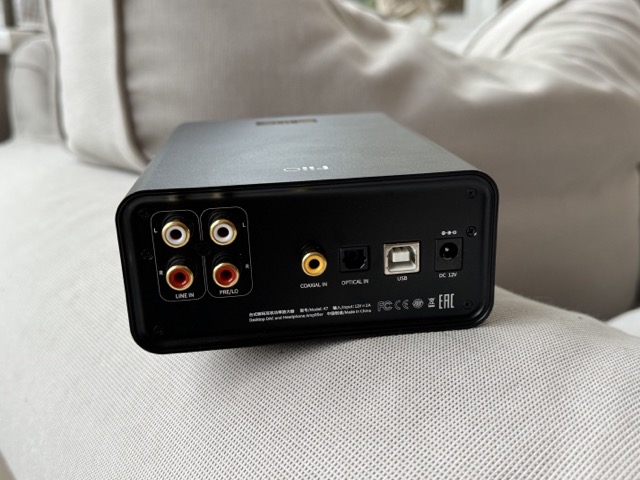
Internals
At the heart of the K7 lies a pair of AK4493SEQ DAC chips and an XMOS XUF 208 microcontroller, each channel being individually catered to. The inclusion of dual THX AAA 788+ modules, typically reserved for higher-end equipment, reflects FiiO’s uncompromising approach to sound quality.
Furthermore, six different audio circuits are in place to prevent issues like crosstalk, enhancing signal purity. The presence of the XMOS XUF208 decoder chip and dual-clock management ensures compatibility with a wide range of music formats, adding to its versatility. FiiO have an impressive balanced architecture within the F7:
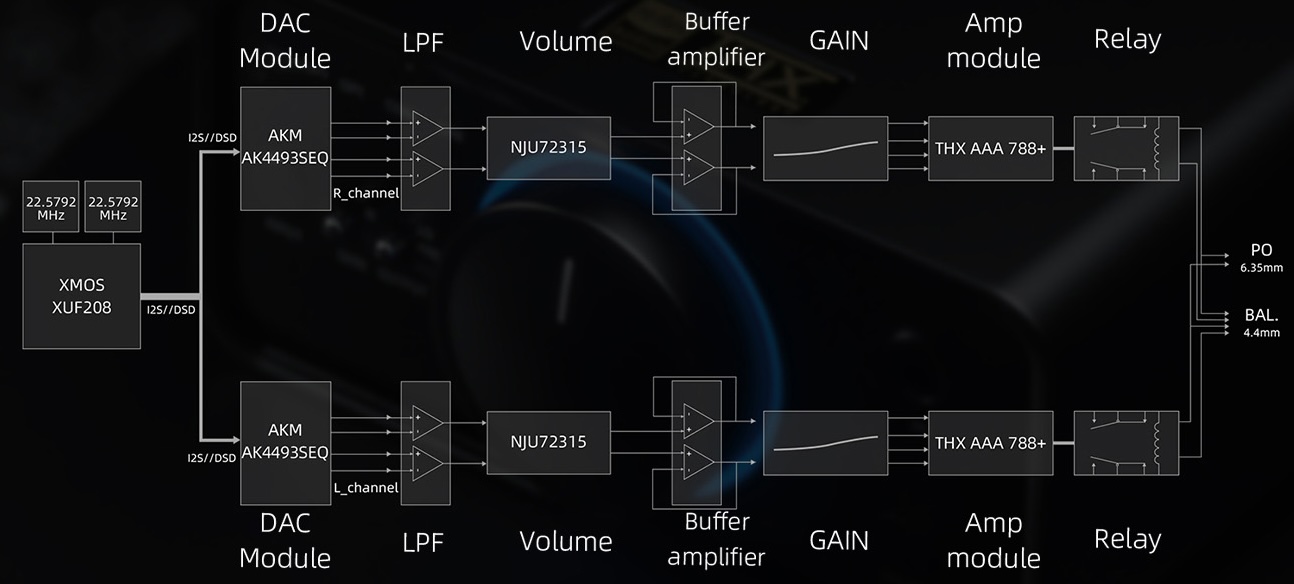
Key Specifications:
| Power | SE | 1.2W (@32Ω) |
| BAL | 2W (@32Ω) & 560mW (@300Ω | |
| THD+N | PO | <0.00028% (1 kHz,32Ω,dbA) |
| LO | <0.0005% (1kHz,10kΩ,dbA) |
Format Support:
In terms of audio support, the K7 is impressively versatile. It handles PCM audio up to 32-bit/384kHz and DSD256 via USB, 24-bit/192kHz through coaxial, and 24-bit/96kHz via optical.
| Maximum supported sampling rate | Channel |
|---|---|
| PCM 384kHz-32bit/DSD256 | USB DAC |
| PCM 192kHz-24bit | COAX |
| PCM 96KHz-24bit | OPT |
Although it does not support MQA, this is becoming less of a concern in the current audio landscape.
Listening impressions and Key Measurements
Impressions:
Quiet simply at this price point this is the best sounding headphone amplifier you can get. Too many < $200 headphone amplifers just haven’t the power to really deliver a bass depth for planars (and provide power to other hard to drive headphones like the Sennheiser HD800 ). The “balanced audio architecture” that FiiO have implemented is exceptional for a clean sound, and as you will see in the measurement the K7 deliveries a flat “frequency response”, so it’s not coloring the sound in any way. So feed a clean digital source (via USB or optical ) and you are hearing how your headphones interpret the audio “transparently” as it should be with a headphone amplifier.
High Gain:
It also has enough power that I did not normally have to use the high-gain with my planars, but again I appreciate that it is available for some future headphone purchases. I do have a few test tracks, for example, John Cage famous 4.33 where I switched to high gain and maximize the power to really test how well a headphone DAC performs. That famous ‘silent’ track is not silent at all, it’s recording obviously has some tape hiss given its age, but with super resolving headphones and a great Amp you can hear extra things like a ticking clock, and dinner plates and the occasional door in the background opening and closing. The FiiO with high gain did not distort the sound or introduce extra noise into the mix and these subtle details all came out crystal clear. This headohone amp therefore has an amazing ability to get all the detail out of a recording.
Key Measurements:
As you can hopefully tell from my listening impressions this is a very clean sounding headphone amp with lots of power.
So FiiO also produce some excellent measurements here but let’s briefly look at some indepedent measurements to back FiiO own measurements claims and I think are inline with my subjective opinions:
Frequency Response - digital input with balanced headphone output:
Thanks to Techpowerup:
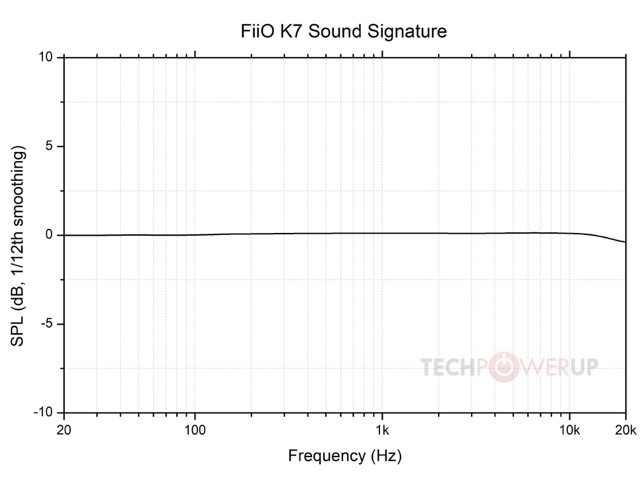
The left scale of this is important as it shows a perfectly linear FR up to 15k and then a slight roll off less than 0.5 dB as it approaches 20k
SINAD
Thanks to l7audiolab
Obviously SINAD is a slightly controversial metric but basically anything with better than 80 SINAD is ‘clean’ sounding and both from the single ended and the balanced the K7 is exceptional:

Here the SINAD of 115 dB is the balanced output (though the Single Ended is also exceptional 113 dB)
Multi-tone distortion:
And finally the multi-tone distortion (again thanks to l7audiolab):
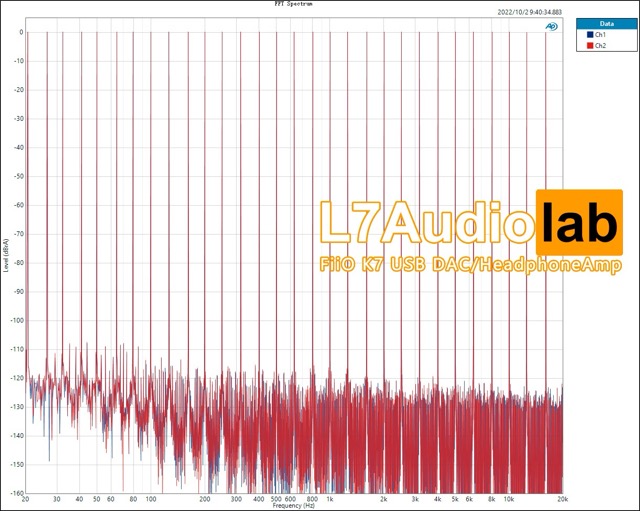
Again, this is exceptionally good, basically when multiple tones are simulateously fed into the Amp it is not producing any distortion below -109 dB well below the audible thresholds.
Rating
I gave this a pragmatic rating of 4 - while it’s still great there are other alternatives now including the FiiO’s K11 which while it has less power it has more features at an even more pragmatic price, but I still believe the K7 is probably the safer bet for someone starting off in the IEM and headphone hobby as it covers everything from the easiest to drive IEM’s to the hardest to drive headphones and has an exceptionally good DAC.
Summary
This can be the only headphone amplifier you will ever need, it measures well, has lots of appropraite features, a great internal clean audio architecture and supports both low impedance headphones, IEMs and high impedance power hungry headphones.
The K7 sets a new standard in what headphone driving performance you can get at a budget-friendly price, making it very much the perfect pragmatic choice.